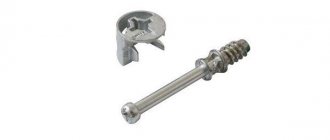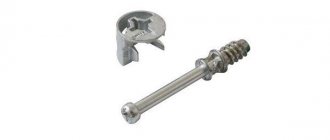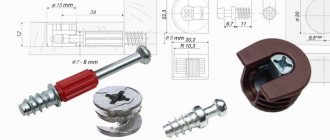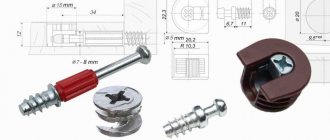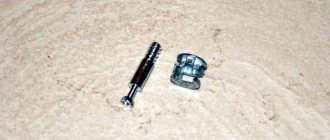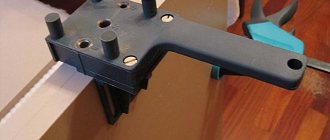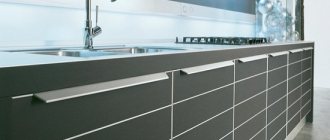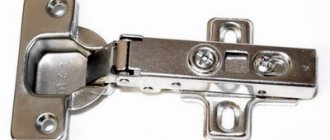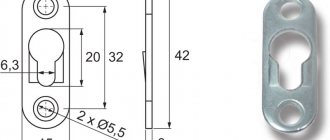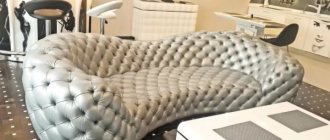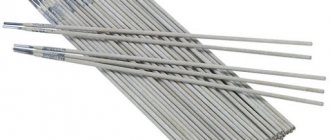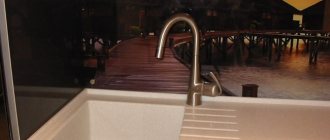When purchasing cabinet furniture, you probably pay attention to how the parts of the product are fastened together. In some cases, manufacturers use nails, in others - self-tapping screws. But perhaps the most reliable method of fastening is an eccentric furniture tie. We will talk about what it is and in what cases this type of fastening is used in this article.
Eccentric furniture coupler
About the eccentric coupler
An eccentric coupler, or, in other words, rastex or minifix, is one of the most practical, durable and convenient types of fastening furniture elements together. The use of such fasteners allows you to disassemble and reassemble furniture without damaging the material from which the furniture is made.
With the help of a minifix, you can easily assemble T-shaped and L-shaped elements when it is not possible to make grooves in them. Often this option for connecting parts is used when assembling tabletops on dining tables and computer tables, the top and bottom parts of cabinets, chests of drawers, and cabinets.
This type of fastener is hidden, and as a result, it can be used without fear that the appearance of the structure will be damaged.
An eccentric connection is a hidden type of fastener, and therefore it is invisible, but, nevertheless, it gives strength to the structure and is not afraid of reuse.
Methods for connecting two or three cabinets
- The easiest way to connect is to drill the walls with self-tapping screws, fitting the sides to each other. This option is convenient when they are comparable in size, and their design is such that the connecting elements will not be noticeable. However, this option spoils the material of the cabinet walls and is not very strong: under the weight, the screws can be torn out of the wall. The resulting hole will be very difficult to repair.
- Another way is to carefully drill holes in the sides, then tighten them together using bolts and nuts. This method provides optimal strength, damages the walls less (especially if you use metal spacers for the bolt heads and washers for the nut), but is not very beautiful in appearance.
- A better option is to use a special furniture tie: this is the same method as with a bolt, but a different design is used here: the bolt is not screwed into an ordinary nut in the shape of a faceted torus, but into a cylindrical unit with a ready-made extension at the end. This screed looks neat, damages the wood less, and does not spoil the appearance of the furniture.
Here, too, it is recommended to place washers under the heads of the cylindrical nut and screw, so as not to damage the sidewall material when tightening. To prevent the heads from sticking out, it is recommended to do countersinking before joining. This is necessary to drown them in the mass of material.Furniture ties are made of steel, and, in addition to the usual grades, other types are used:
- chrome plated;
galvanized;
- Nickel plated.
Help
You can find plastic ties on sale, but the screw in them remains metal. They are cheaper, but much less durable than pure steel fasteners.
What is this type of fastening?
Minifix is a fastener consisting of several components:
- eccentric;
- stand or rod;
- futorka;
- dowel;
- sleeve made of plastic or metal;
- stub;
The parts are sold in different configurations and may differ from each other in length, diameter, type of fitting and method of fastening, which can be a screw or self-tapping screw.
Components of an eccentric coupler
Video description
Furniture assembly. Intersectional furniture screed.
For table top
If the piece of furniture consists of several parts, then a screed for the countertop is needed. Fasteners are used for rigid fastening. The part joins the structure in such a way that the individual components do not move apart horizontally. The model is ideal for kitchen furniture. Based on the type of contraction, there are 3 types:
- Nuts. The long steel rod is complemented by washers on both sides.
- Gearbox with cylinder. Consist of a barrel and a stud with double-sided thread.
- QUICK. The structures have a tie with a self-tapping screw and a counter piece.
Paired fasteners are mounted in prepared holes. Holes are made using a Forstner drill and a groove is created with a chisel. The connecting part is placed in the free areas, and the nuts are carefully tightened with a wrench.
For connecting flat structures Source vsecuplu.ru
Advantages and disadvantages
Like any type of fastener, an eccentric connection has its positive and negative sides. Let's look at them using a table as an example.
Table 1. Advantages and disadvantages of an eccentric coupler
| Advantages | Flaws |
| 1. Furniture can be assembled and disassembled quickly and effortlessly. 2. Possibility of repeated assembly and disassembly of products. 3. The most reliable and durable mounting option. 4. Does not spoil the appearance of the product. 5. Possibility of fastening products at different angles. | 1. High price of fasteners. This increases the cost of the product as a whole. 2. The installation technology is quite complex. 3. The need for perfectly accurate calculations for marking locations for fastenings. |
What does an eccentric coupler look like when it's in place?
Which fastening hardware to choose for certain types of material
Modern manufacturers make furniture not only from chipboard, but also from other materials.
Thanks to the wide range of fittings, you can choose fasteners for any type of furniture
Table 6. Selection of fasteners based on the furniture material.
| Material | Description |
| Glass | Fasteners such as self-tapping screws (of the “quick installation” type) are used, which are screwed into the wall. Usually this is a thin self-tapping screw with a plastic attachment. Also, fasteners can have a special adhesive composition and a rubber gasket. They provide fixation of shelves and glass surfaces, while the furniture coating is not damaged. Glass doors on a cabinet can be installed using regular furniture hinges. |
| Metal | Screw fasteners are ideal for connecting metal parts. They can be fixed to the stand using a screwdriver/drill. To prevent the furniture from losing its aesthetic appearance, the head of the fasteners can be closed with a plug. |
| Plastic and chipboard | To fix such furniture, you can use any fasteners that are designed for chipboard. |
Telescopic guides for drawers are modern fittings that allow you to effortlessly open even massive structures. Would you like to learn in detail about the installation of telescopic guides and the correct calculation for their installation? Read the special article.
Types and sizes
The eccentric coupler comes in plastic and metal. Depending on the material of manufacture, it is used in one field or another. For example, small pieces of furniture can be secured with plastic fasteners, but for large items, such as cabinets or kitchen units, it is advisable to use metal fasteners.
The dimensions of the parts also vary, for example, the length of the stand can vary from 38 to 58 cm, the diameter of the minifix can be of three sizes:
- 12 mm;
- 15 mm;
- 25 mm;
The most commonly used fastener is 15 mm in diameter.
The dimensions of the eccentric coupler parts may also vary.
Main types of furniture fittings
When choosing furniture, it is important to pay attention not only to its appearance, because parameters such as durability and functionality will be more important. The fittings that are equipped with each product are responsible for these characteristics. There is a wide variety of details that simplify use and increase the service life of furniture.
For normal functioning, furniture is equipped with a variety of fittings
Door handles
There are three main types of pens, these are:
- stationary;
- with a push mechanism;
- rotary.
Stationary models are found exclusively on cabinet doors and bedside tables. They are not equipped with a lock; they allow you to pull or push the door and often have a decorative function. The remaining types are distinguished by the presence of a latch or lock, so they are much more common.
It is impossible to imagine a single door without handles
Wheels
Today on the furniture market you can find a lot of models of furniture on wheels. They are necessary for the free movement of the product around the house. Each type of wheel is different:
- adjustment parameters;
- fastening;
- rotation method.
When choosing such accessories, it is important to pay attention not only to quality and attractive appearance. It is necessary that the wheels match the style of the furniture (on which they will be attached) and the room as a whole.
Wheels for furniture come in different sizes
All types of wheels can be divided into two main subtypes.
- Swivel - allow you to move furniture around the house without much effort.
- Fixed - able to withstand heavy loads, but do not have good maneuverability, so furniture is much more difficult to move.
Legs
Almost all types of furniture must be equipped with legs/supports. Since they support the entire structure, the legs must be of high quality, but we must not forget about their design. This type of fittings can be divided into 3 groups.
- Regular, without height adjustment. They often represent an inexpensive support for furniture. They feature a laconic design.
- Models with the ability to adjust height. These legs are ideal for rooms with uneven floors, allowing you to level the furniture.
- Decorative - used as decoration. Models can be varied, for example, with threads, non-standard shapes.
Legs are usually present on the base of the cabinet, as well as chairs, tables.
Metal models are usually made from:
- chromium;
- aluminum
They are durable and strong. Such legs harmoniously combine with various interior items.
Wood is often used to create decorative models. It is better to choose legs made of expensive wood, since they differ:
- attractive appearance;
- high quality.
Plastic models do not differ in aesthetic appearance, however, they compensate for this:
- wide range of sizes;
- functionality.
An example of what adjustable legs look like
Loops
Furniture hinges refer to connecting fittings that allow doors to be opened/closed. There are different types of hinges, they depend on the configuration of the cabinets and their facades. Such fittings can be equipped with closers for silent and smooth operation.
Hinges are a mandatory part on the cabinet that ensures the functioning of its door.
Table 7. Main types of loops.
| View | Description |
| Invoices | The most common hinges that allow doors to open 110 degrees. Used on swinging facades. |
| Semi-overhead | Such canopies are used to equip cabinets, the doors of which are fixed on one side and swing open in different directions. They allow the door to open 110 degrees. |
| Domestic | Such hinges are used to equip facades that are located between two side parts. They provide door opening 100 degrees. |
| Corner | Ideal for a corner drawer. The door can only be opened 90 degrees. |
| Adit | They are attached to overhead strips located at the same level as the furniture facade. The doors can only be opened 90 degrees. |
| Complex | Used for corner boxes with L-shaped frames. The hinges are attached in the middle of the two facades, ensuring their synchronous opening. |
| Transformer | They are used in conjunction with complex canopies. The hinge is capable of holding two facades on itself at the same time and allows you to open the doors at a large angle. These hinges are also appropriate if the cabinet is equipped with a drawer. |
Furniture hinges with a closer are expensive fittings with a complex design. Thanks to the shock absorber built into the hinges, the doors will close independently. Would you like to get acquainted with the varieties of this fittings in detail? Then read our specially prepared article.
Locks
The purpose of this fitting is to allow the door to be fixed in one position. There are three types of locks:
- latch;
- lock with key;
- lock for the bathroom.
The latches have simple functionality - to operate them you just need to slam the door. Often, doors with a push handle are equipped with such a mechanism.
Locks look appropriate on furniture made of any material
Key locks allow doors to be locked to prevent unauthorized access. Models for the bathroom are a mechanism with a turntable that can be closed from the inside. This option is more appropriate for ordinary doors than for furniture.
Mortise locks will also be relevant for furniture. They have a high reliability index, and most importantly, do not spoil the appearance of the furniture. There are such locks:
- cruciform;
- cylinder;
- suvaldnymi.
Lever locks work on the principle of moving metal plates into grooves.
The simplest is considered to be a furniture lock. They can be mounted on furniture made of chipboard and glass. They are even suitable for double doors.
Hooks
This type of fittings must withstand heavy loads, so when choosing hooks it is important to pay attention to the quality of the metal from which they are made. The hooks are different:
- shape;
- style;
- sizes;
- functionality;
- design.
Among the most popular hooks are one, two and three-arm models. They can be attached independently to any furniture. The purpose of this accessory is to store various things, mainly clothes.
An example of what the main types of furniture hooks look like
Instructions for creating holes for an eccentric tie
Step No. 1 – mark the drilling locations. Before you begin installing the hitch, you must accurately mark the places where the necessary holes will be drilled. You can mark manually using a ruler or template, or you can use a special device - a jig. We'll talk about it below.
First of all, you need to mark the places for attaching the screed using a ruler or template.
Step No. 2 - drill a place for the rod. Next, in one of the two parts to be connected, we drill a groove for the rod. It is important that it does not go through, so use a stopper. We screw in the rod, leaving it to protrude 6 mm above the blade.
Next, you need to drill grooves in the material, into which the rod will be inserted later
Step No. 3 - make a groove for the eccentric. The next step is to drill a hole for the eccentric. This is done using a Forstner cutter. And here the depth is important, on average 15 mm will be enough. The groove should not be through, the eccentric should fit into it to its full height and be flush with the surface of the workpiece. On the product, using a template or ruler, measure a distance of 33.5-34 mm from the bottom edge and 5 cm from the side end. The intersection point will be the center of the hole.
The hole for the eccentric segment of the connection is drilled using a special cutter
Step No. 4 - drill a passage for the rod. And the final stage in preparing places for fastening will be drilling a passage for the rod in the same element in which we will place the eccentric, only from the end side of the part. It is done with an 8 mm drill and should be located exactly relative to the center of the niche for the eccentric and exactly in the middle of the end part of the part itself. When working, it is important to use a ruler, tape measure, or, if you have a special jig, a template. Otherwise, misalignment of the grooves may result in you not being able to assemble the furniture neatly and evenly.
Next you need to drill a passage for the rod
The holes are ready and all that remains is to connect the parts of the future structure. To do this, we apply one workpiece to another so that the rod enters the passage. We insert the eccentric into the groove and use a Phillips screwdriver to tighten the minifix, thereby firmly and securely fastening the furniture elements together.
Provided that you followed the instructions carefully, the furniture connection will be installed without problems
With correct and accurate calculations and following all instructions, your furniture pieces should fit perfectly into a single plane, without protrusions or distortions.
Installation features
It is quite difficult to use this method independently when making furniture. The holes are not only difficult to drill, but it is also impossible to further correct the joints during assembly of the parts. The main difficulty when drilling is making a hole for the eccentric. This is a blind hole that requires the use of a Forstner drill. For a standard eccentric, you need to use a drill with a diameter of 1.5 cm.
To make a hole for the eccentric, it is necessary to correctly mark the part. Afterwards, holes are made for the eccentric using a Forstner drill. At the end of the part, a hole is made for the rod using a drill with a diameter of 8 mm. The parts are connected to each other and fixed by turning the eccentric 180 degrees clockwise.
The sampling depth should be about 12 mm. And the thickness of the laminated chipboard panel is 16 mm. Only 4mm of undrilled wall thickness remains. The difficulty of installing a furniture screed yourself lies in the risk of drilling through the part. To do this, when drilling holes for the eccentric, drills with limited depth are used.
What is a furniture jig and how to use it
If you have a furniture jig, this will make it much easier for you to mark and drill holes for any type of fastener. A jig is essentially the same template, which is a special device or bar on which holes of different diameters and at different distances are applied. With their help, you can make perfectly accurate markings and drill passages of the size you need. Various materials are used to make this assistant:
- metal;
- plastic;
- tree;
- wood boards.
The product is a solid base with many holes at different distances required from each other. Additionally, it can be equipped with a mechanism for fixing and adjusting the distance between the holes.
Use a special drilling jig to help you hold the drill at the right angle.
Thanks to the device, you will install the drill exactly at a right angle to the blade, without deviations. This is a great help when working on narrow surfaces, such as the ends of chipboards. After all, if the groove is not located at an angle of 90 degrees, assembling the body elements into a single whole may become impossible.
Types of conductors
Depending on the functions performed and design features, templates can be of several types:
- Invoices. This type of device serves as an assistant for drilling holes on flat elements by placing it on the workpiece. The device is not attached, but only held by hand. Suitable for use on chipboard or fibreboard surfaces.
- Rotary. The rotating device allows you to move it vertically or horizontally and rotate it at different angles. This device is convenient to use provided that the part that needs to be drilled has a complex shape.
- Tiltable. Tiltable assistants are convenient for working with elements that are located in planes that are different from each other.
- Universal. The devices are convenient because they can be customized for the production of furniture of various configurations.
All types of templates can have a sliding or fixed type of fit to the surface. The sliding type allows you to move the product along the surface of the workpiece. Fixed option - firmly fixed in the desired position and does not move.
The conductor is the furniture maker’s best assistant, without him it would not have been possible to connect furniture so beautifully
What to look for when choosing a conductor
When choosing a furniture jig in a store, you should carefully examine the product and pay attention to the material from which it is made. For example, stainless steel products will be high-quality and reliable.
The manufacturer matters too. World-famous brands, as a rule, produce high-quality tools with a long service life and a warranty from the manufacturer.
The more famous the brand, the higher the quality - a rule that works flawlessly in the case of construction tools
When purchasing such an assistant, take an interest in the additional equipment that comes with the kit. The versatility of the device will make your work easier. The more tools included in the package, the more cases you will be able to use it. For example, a set may include
- various bushings;
- drills of various diameters with stops;
- Forstner cutter, for holes for minifixes;
- keys.
There are a significant number of advantages in using this device.
By using a template in the manufacture and assembly of cases, you will save yourself from many inconveniences. For example, you don't need to mark places with a ruler and pencil. The jig allows you to fix the distance and drill several absolutely identical holes at the same distance from each other. There is no inaccuracy here.
But a factory-made conductor also has a drawback - its rather high price.
Therefore, craftsmen are quite capable of making such an assistant with their own hands. Our instructions will help you with this.
Instructions for making a furniture jig
Step No. 1 – prepare tools and materials:
- square metal block, section 1x1 cm;
- Bulgarian;
- file;
- calipers;
- awl or thick needle;
- drills with a diameter of 5 mm;
- metal plate for stop measuring 1x25 mm;
- a sheet of sandpaper.
First, let's collect all the tools and materials necessary for the work.
Step No. 2 - make the base and markings. Using a grinder, cut off a piece of the required length from the block. Sand any burrs with a file. Mark the locations for future holes. The generally accepted dimensions are the distance between the grooves is 32 mm, the distance from the centers of the slots to the side edge is 8 mm. To make the markings accurate, use a caliper. It is convenient if you mark the centers of future grooves using an awl or needle.
Make the markings, you can first do it on paper, then transfer it to the material itself that requires connection
Step No. 3 – install the tool. Next, we drill passages in the required quantity. Then we take a metal plate and grind it with sandpaper if necessary. Clamping it with a vice, we bend our plate at a right angle. Align the resulting parts and clamp them with a clamp. Fasten the parts with screws, having previously cut the thread to the desired size. Thus, you can create a very convenient tool for yourself.
Next we drill the holes
Types of fastening hardware
Depending on the type of furniture and its purpose, the designs of fastening elements differ. They can:
- fix the product from the inside, creating a strong frame;
- secure the furniture base to the floor or wall.
Each type of fittings has different characteristics and features. Some fasteners will be appropriate for assembling glass furniture, others for chipboard.
Main types of furniture fasteners
Furniture corners
One of the simplest and oldest types of fasteners. Even a novice furniture assembler can handle such a corner. Based on it, you can design and assemble almost any structure. The main advantage is that installation can be carried out with a minimal set of tools, without any specific skills.
Table 1. Main types of furniture corners.
| Material | Description |
| Plastic | Installation is carried out using self-tapping screws. These corners are different:
|
| Metal | They are a part with stiffening ribs. Made in the form of a 90 degree angle. To fix them, you can use screws, couplings from:
|
Often, corners are used to fix all cabinet parts together. This is also a common fitting used to equip cabinet kitchen furniture. The main disadvantage of such fasteners is that they need to be tightened regularly, as they will gradually become loose.
Confirmat
The second name of confirmat is Euroscrews, Euroscrews. This is a fairly easy to install screw that does not require precision. Its installation requires the use of:
- drills;
- screwdriver.
This is the most common type of screws for furniture.
The confirmat cap is equipped with a connector for a hex key, which is used to tighten the screw. To install it, you need to make two holes in the furniture - the first in the end of the part, the second in the element that needs to be attached. This screw is quite easy to install, so you can drill holes for it immediately before assembling the structure.
Confirmation structure and standard sizes
For installation of the confirmat, a special drill is used. However, according to most craftsmen, such a device is not relevant - it is difficult to work with it, since it regularly:
- gets clogged;
- staggers.
Therefore, to obtain the necessary holes, you can use ordinary drills. The most common is the confirmat size of 7 * 50 millimeters.
Table 2. Advantages and disadvantages of confirmat.
| pros | Minuses |
| 1. Installation does not require special equipment, so assembling the furniture is quite simple. 2. Provides reliable fastening of parts. 3. Withstands heavy loads. 4. Installation is possible using a mallet. | 1. If you do not use plugs that match the color of the furniture, the confirmation hat will be visible. 2. Confirmat cuts threads inside the part, which can cause its deformation. 3. If furniture is assembled using confirmat, it cannot be disassembled more than three times. |
After studying the table, you can see that the confirmat does not cause any difficulties when working with it and provides a reliable screed. However, if possible, it is better to replace it with an eccentric coupler.
With frequent twisting/twisting, the confirmat damages furniture parts, which negatively affects the strength of the entire structure
Dowels
Dowels are wooden cylindrical fasteners, their size is usually 8 * 35 millimeters (length and diameter). The main advantage of these fasteners is that they are invisible from the inside and outside.
Concealed fastening fittings for furniture
Also, dowel fastening has a couple of disadvantages.
- You can only do it once. It is quite difficult to dismantle and reassemble furniture without damaging it.
- Jeweler's precision is required when preparing holes. To comply with this condition, the use of special equipment may be required.
What does a box jig look like?
Instruction No. 1 - how to install a dowel
Installation of this fittings is extremely simple, you just need to follow certain rules.
Step No. 1 – holes for fasteners. Holes must be made in each part using a drill. It is important that they completely coincide with the position of the axis.
The holes for the dowels must be coaxial
Step No. 2 – installation. Dowels must be inserted into the prepared holes on one part. They should only go halfway deep. To increase strength and secure the fasteners, you can add PVA glue to the holes.
Example of how dowels should be inserted
Step No. 3 – furniture assembly. Now you need to secure the second piece of furniture. To do this, you just need to place it on the protruding edge of the dowels.
If everything is done correctly, the dowels will tightly secure the furniture parts
Instruction No. 2 - how to make a jig for dowels yourself
You don’t have to buy a conductor in a store, because it’s quite easy to make it yourself using available materials. It is necessary to take into account that separate templates are required for different diameters of dowels. To create a conductor you will need:
- wooden blank;
- plywood;
- metal tubes;
- drill/screwdriver.
Supplies for a homemade template
Step #1 – holes. Through holes should be made in the wooden blocks, it is important that they are located strictly at an angle of 90 degrees. The diameter of the drill must correspond to the dimensions of the metal pipes.
What wooden blanks with holes should look like
Step No. 2 – processing of plywood. You need to cut three rectangular pieces from plywood and make holes in them. The edges of the plywood can be sanded with sandpaper to remove chips.
The width of the plywood sheets must correspond to the size of the bars
Step No. 3 – forming the conductor. It's time to put the whole structure together. To do this, you need to apply epoxy glue to the metal tubes and insert them into the prepared holes in the wooden blocks. When the glue has dried, you can begin fixing the plywood sheets. They can be attached to the beams using PVA.
When the glue on the homemade jig is completely dry, the template will be suitable for use.
Video – Conductor for DIY dowels
Ties
To fasten furniture parts, 2 types of ties are used. They differ from each other in certain features.
Table 3. Types of furniture ties.
| View | Description |
| Eccentric | Such fittings are used exclusively under factory assembly conditions. To install the screed, a special device is required to make an accurate hole. The main advantage of this screed is its invisibility, making the furniture look:
|
| Intersectional | It is presented in the form of a screw with a nut, which allows you to tighten two perpendicular pieces of furniture together. This type of tie is ideal for fixing:
|
Shelf supports
This type of fittings is very diverse. It is usually divided into fasteners for glass and chipboard. Shelves that harmoniously combine two different types of materials look interesting. To obtain a high-quality screed between them, it is necessary to use shelf holders. Such fittings happen:
- with fixation;
- without fixation.
It is better to choose shelf supports only from high-quality material
Table 4. Differences between shelf supports for chipboard and glass.
| Options | For glass | For chipboard |
| Design | Contains screw and rod. | It consists of a self-tapping screw and a holder. |
| Installation | They are fixed to the cabinet walls with screws, and a shelf is placed on the base. | The self-tapping screw needs to be screwed into the wall of the cabinet, and the holder will fix the plane of the shelf. |
| Advantages | It has an attractive appearance and provides reliable fixation of the shelf. | The reliability of the design is ensured by the threads in the cabinet material. |
| Flaws | To protect against loosening and damage, an elastic gasket is required. | Precise holes must be made. It is important that they match on the wall and shelf. |
Shelf holders must match the style of the furniture and be in harmony with other interior items
Bolt nut
For quite a long period of time, a system such as a bolt-nut has been used to connect furniture surfaces. Holes are made in each part for such fasteners. A bolt is inserted into it on one side, and a nut is screwed on the other. Today, such fastening hardware is not used so often, despite its advantages. The bolt head has a semicircular shape, which, after fixation, does not rotate, remaining in a static position.
The bolt nut has lost its relevance with the advent of modern fittings
Despite its ease of operation, the bolt-nut system has shifted to the background after the advent of more modern types of fastening hardware. However, it still remains relevant when assembling furniture, especially for novice craftsmen.
Table 5. Advantages and disadvantages of bolt-nut fasteners.
| pros | Minuses |
Among the advantages of the bolt nut are:
| There are only two disadvantages. 1. Visibility - after installation, such fasteners remain visible. Because of this shortcoming, the bolt-nut has lost its relevance today. 2. The ability to connect exclusively parallel surfaces. |
Video - Main types of furniture connections
Other options for furniture ties: a brief overview
As we have already found out from the above, the eccentric coupler is one of the most durable fasteners. But it is not always advisable to use this type of connection. Let's look at what other fastenings are used by cabinet furniture manufacturers.
Confirmat
Confirmat is one of the most popular and easy-to-install connection options. Fastening the body parts using confirmations is not difficult or difficult. This type of fastening can only connect elements at right angles.
Confirmat - another detail of furniture fasteners
To install furniture parts using a confirmat, you will need to drill a groove along the diameter of the fastener head in one of the workpieces, the second hole must be made in the end part of the other workpiece, but the diameter will be smaller - usually two drills of 5 and 6 mm are used. Although, you can also use a combination type drill - this is convenient, since you will work with only one tool, and there will be no need for constant replacement.
For greater reliability, confirmations are recommended to be used together with a small wooden rod - a dowel. Such a rod will prevent the workpieces from moving when secured with a confirmat.
This type of coupling, unlike the eccentric one, does not allow parts of the product to be fastened several times
But when using this type of hitch, you should know that chipboard products should be fastened once. Due to the high hollowness of chipboard, re-joining with confirmat does not guarantee a strong screed.
Confirmat is a connection that, unlike an eccentric coupler, is visible on the surface of the product. Therefore, to hide it, you can use decorative stickers or plugs that match the color of the body surface.
Intersectional screed
This fastening method is used when it is necessary to connect modules to each other, for example, cabinets or mezzanines. The coupler consists of two parts - a nut (bushing) and a screw. Since the chipboard used to make the cabinets has different thicknesses, the intersection screed can also be of different sizes.
Intersectional screed
To fasten two modules with this type of connection, it is necessary to align the elements being fastened and drill matching through holes in the two walls of the housing. Insert a bushing on one side, a screw on the other side and tighten with a screwdriver. Sections are fastened.
Furniture corners
This type of fastening has long been known to everyone. They are made of metal and plastic, and are mounted using self-tapping screws. It is not recommended to use corners in those parts of the furniture that are expected to be loaded.
Furniture corners
Table top screed
This type of hitch is used in the production of kitchen sets. It consists of a screw and a pair of stops. Holes for such a screed are made using a Forstner cutter of the required diameter, and a channel for the screw is cut out with a jigsaw.
Holes for such fastening are also made using a Forstner cutter
Furniture corner
This type of fastener is used to connect two parts. This is a rather fragile connection method, so it is used to fasten parts that are not expected to be affected by heavy loads. Usually these are decorative elements, for example, the base of a wardrobe or mezzanine shelves.
Fig.21.
The furniture corner is used for fastening decorative furniture elements (plinth) and installing shelves. Made from plastic. It has a cover to hide the fasteners. Self-tapping screws 16 mm long are used as fasteners.
Plastic corners are often used instead of metal ones. They are no less durable, but have a more attractive appearance and the possibility of hidden fasteners. The furniture corner is attached to two mating parts using two self-tapping screws. Then the lid is snapped on, thus hiding the fasteners.
Fig.22.
A furniture corner is used for fastening low-load furniture elements, including for installing decorative elements such as a plinth, inserts, etc.
The furniture fasteners discussed in the article are the most common and most frequently used, due to the fact that these are the most versatile and easy-to-use types of fasteners. In the vast majority of cases, the types of furniture fasteners described are sufficient to assemble any furniture.
Carriage screed: features and differences
The carriage screed has its name for a reason. Its use has been known since the mid-18th century. At that time in France, during the reign of Napoleon III, this type of decoration was actively used to decorate the interior decoration of carriages. "Capitone" was considered a symbol of wealth, luxury and high status of a person. Later, the carriage screed technique began to be used in other European countries, appreciating its beauty.
Until now, the popularity of such finishing of backs and other furniture elements remains quite high. For example, one of the signs by which you can recognize a soft Chesterfield sofa.
It is loved by those who do not tolerate trivial decisions in the interior and are always looking for special and unique things for their home, be it furniture, interior doors or accessories.
The Capitone technique is also used to decorate large wall panels that occupy the entire space from floor to ceiling, various furniture elements, be it the back, armrests or seat.
Sometimes it is used to decorate various small interior items, such as pillows or mattresses. It is very easy to recognize a carriage tie: it always has soft upholstery, which seems to be held together only by buttons. In this case, the stretched fabric forms a symmetrical pattern: squares or diamonds of the same size.
As a rule, for the outer upholstery of chairs, sofas or beds, dense and wear-resistant fabrics are chosen that are easy to clean and will last for many years. Usually it is: leather - natural, artificial, eco, suede, flock, velor or velvet.
Buttons with threads, special furniture nails decorated with rhinestones, pearls or beads are used as fixing elements.
